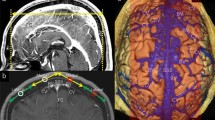Summary
No precise intra-operative monitoring of venous blood flow has yet been developed for neurosurgical procedures. Preservation of the bridging veins is an important issue in order to minimize complications due to disturbances of venous blood flow during an inter-hemispheric approach. In the present study, venous blood flow velocity was measured in 11 anterior circulation aneurysms. The measurement was performed before brain retraction, during brain retration and after completion of the procedure without brain retraction. In 6 cases, a bridging vein was dissected completely free from the dura up to its entry into the superior sagittal sinus (SSS group). In 5 cases, dura was cut parallel to the bridging vein so that the vein remained covered by the dura (dura group). Venous blood flow velocity was measured by microvascular Doppler sonography. The results show that venous blood flow can be better preserved during the retraction when the bridging vein remains covered with the dura than if the vein is dissected completely free from the dura.
Similar content being viewed by others
References
Albin MS, Bunegin L, Helsel P, Marlin A, Babinski M (1980) Intracranial pressure and regional cerebral blood flow responses to experimental brain retraction pressure. In: Shulman K, Marmarou A, Miller JDet al (eds) Intracranial pressure IV. Springer, Berlin Heidelberg New York, pp 131–135
Andrew BT, Dujovny M, Mirchandani HG, Ausman JI (1989) Microsurgical anatomy of the venous draininge into the superior sagittal sinus. Neurosurgery 24: 514–520
Donaghy RMP, Numoto M, Wallman LJ, Flanagan ME (1972) Pressure measurement beneath retractors for protection of delicate tissues. Am J Surg 123: 429–431
Hernesniemi J, Tapaninaho A, Vapalahti M, Niskanen M, Kari A, Luukkonen M (1992) Saccular aneurysms of the distal anterior cerebral artery and its branches. Neurosurgery 31: 994–999
Rosenorn J, Diemer NH (1982) Reduction of regional cerebral blood flow during brain retraction pressure in the rat. J Neurosurg 56: 826–829
Sakaki T, Morimoto T, Takemura K, Miyamoto S, Kyoi K, Utsumi S (1987) Reconstruction of cerebral cortical veins using silicone tubing. J Neurosurg 66: 471–473
Sugita K, Kobayashi S, Yokoh A (1982) Preservation of large bridging veins during brain retraction. Technical note. J Neurosurg 57: 856–858
Tsutsumi K, Shiokawa Y, Sakai T, Aoki N, Kubota M, Saito I (1991) Venous infarction following the interhemispheric approach in patients with acute subarachnoid hemorrhage. J Neurosurg 74: 715–719
Yokoh A, Sugita K, Kobayashi S (1983) Intermittent versus continuous brain retraction. An experimental study. J Neurosurg 58: 918–923
Author information
Authors and Affiliations
Rights and permissions
About this article
Cite this article
Morimoto, T., Yamada, T., Ishida, Y. et al. Monitoring of venous blood flow velocity during interhemispheric approach for deep seated lesions. Acta neurochir 137, 44–47 (1995). https://doi.org/10.1007/BF02188779
Issue Date:
DOI: https://doi.org/10.1007/BF02188779




